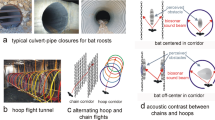Summary
The ability of cave dwelling swiftlets (Collocalia spodiopygius) to detect small cylindrical obstacles by echolocation was tested in a 3x9 m flight chamber. Although there was great individual variability, 6.3 mm obstacles were avoided much more often in total darkness than 1.5 wires (P<0.001). Flash photographs showed that the latter were avoided only by chance (about 50% misses). Obstacles 3.0 mm in diameter were avoided only slightly more often than 1.5 mm wires.
Even in the light these swiftlets avoided the obstacles in only about 75% of the trials, probably because gentle touches with the primary feathers caused little discomfort.
The 3.0 and 6.3 mm obstacles tended to be avoided more often on first encounters after they had been shifted horizontally by 10–30 cm, probably because the birds became more attentive.
Similar content being viewed by others
References
Fenton MB (1975) Acuity of echolocation in Collocalia hirundinacea (Aves, Apodidae), with comments on the distributions of echolocating swiftlets and Molossid bats. Biotropica 7:1–7
Griffin DR (1958) Listening in the dark. Yale University Press, New Haven, CT (reprinted 1974, Dover Publications, New York)
Griffin DR, Suthers RA (1970) Sensitivity of echolocation in cave swiftlets. Biol Bull 129:495–501
Griffin DR, McCue JJG, Grinnell AD (1963) The resistance of bats to jamming. J Exp Zool 152:229–250
Henson OW, Schnitzler H-U (1980) Performance of airborne biosonar systems: II. Vertebrates other than microchiroptera. In: Busnel R-G, Fish JF (eds) Animal sonar systems. Plenum, New York, pp 183–195
Jen PH-S, McCarty JK (1978) Bats avoid small moving objects more successfully than stationary ones. Nature 275:743–744
Konishi M, Knudsen EI (1979) The oilbird: hearing and echolocation. Science 204:425–427
Medway L, Pye JD (1977) Echolocation and the systematics of swiftlets, chap 19. In: Stonehouse B, Perrins C (eds) Evolutionary ecology. University Park Press, Baltimore, pp 225–238
Neuweiler G, Moehres FP (1967) The role of spatial memory in the orientation. In: Busnel R-G (ed) Animal sonar systems, biology and bionics. Laboratoire de Physiologie Acoustique, Jouy-en-Josas, France, pp 129–140
Smyth DM (1980) Studies on Echolocation in the grey swiftlet, Aerodramus spodiopygius. PhD thesis, James Cook University of North Queensland, Townsville, Australia
Author information
Authors and Affiliations
Rights and permissions
About this article
Cite this article
Griffin, D.R., Thompson, D. Echolocation by cave swiftlets. Behav Ecol Sociobiol 10, 119–123 (1982). https://doi.org/10.1007/BF00300171
Received:
Accepted:
Issue Date:
DOI: https://doi.org/10.1007/BF00300171




